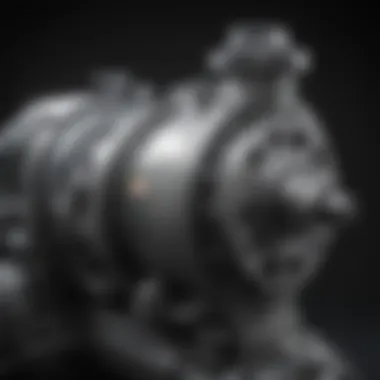In-Depth Insights into Centrifugal Pumps: Operation and Applications


Intro
Centrifugal pumps are essential on many applications across various industries. They help transport fluids effectively by converting rotational energy into hydraulic energy. Understanding how these pumps work is crucial for students and professionals in mechanical engineering and fluid mechanics.
The fundamental design consists of a rotating impeller, which transfers energy to the fluid. This process creates a pressure difference, drawing fluid into the pump and discharging it at a higher pressure. Their construction may vary, but the basic principle remains the same.
Key components of centrifugal pumps include the impeller, volute casing, bearings, and shaft. Each part plays a role in the efficiency of fluid movement. Misalignment or wear in any of these components can hinder performance.
Centrifugal pumps find applications in many areas: water supply and sanitation, chemical processing, and HVAC systems, to name a few. Recognizing their various roles gives insight into their versatility and importance in everyday operations.
Effective operation and longevity require regular maintenance. This article will delve into proper maintenance practices, operational efficiency strategies, and troubleshooting techniques. By exploring these factors, readers will gain a comprehensive understanding of centrifugal pumps and their impact on fluid transport systems.
Prologue to Centrifugal Pumps
Centrifugal pumps play a crucial role in various industries, from manufacturing to agriculture. Understanding them is vital for professionals who are involved in fluid movement. They are used widely for their efficiency and effectiveness in transporting fluids. This section provides a clear understanding of what centrifugal pumps are and establishes context for their importance in modern engineering and industrial processes.
Definition and Overview
Centrifugal pumps are mechanical devices designed to transfer fluids by converting rotational kinetic energy, typically from a motor, into hydrodynamic energy. This energy conversion process leads to increased fluid velocity, which subsequently translates into pressure. The main components of these pumps include an impeller, which is the rotating part that adds energy to the fluid, and a volute casing where the fluid slows down, leading to pressure buildup. The basic function revolves around imparting motion to the liquid and facilitating its transport through piping systems.
Historical Context
The concept of centrifugal pumps traces back to ancient civilizations. Historical records indicate that Archimedes conceptualized the basic principles of fluid movement. However, significant advancements occurred during the Industrial Revolution. The 19th century saw an evolution in pump design, including the creation of more efficient impellers and materials that could withstand internal stresses. Today, centrifugal pumps are optimized with advanced technologies for computerized monitoring and control, reflecting ongoing innovations in mechanical engineering. These historical milestones underscore the continuous evolution of pump technology and its increasing relevance in various fields.
Principles of Operation
Understanding the principles of operation behind centrifugal pumps is crucial for anyone involved in fluid mechanics or mechanical engineering. This section explores the fundamental aspects of how these pumps function, the dynamics of fluid movement, and the key mechanisms behind energy transfer. Knowing these principles not only aids in selecting the right pump for specific applications, but also in optimizing their performance, troubleshooting issues, and maintaining efficiency.
Fundamental Concepts
Centrifugal pumps operate on a straightforward principle: they convert rotational energy, usually from a motor, into kinetic energy in the fluid. The heart of the pump, the impeller, plays a vital role in this process. As the impeller spins, it generates a centrifugal force that pushes the liquid outward from the center of rotation.
This movement creates a pressure differential that draws fluid into the pump. Depending on the design, different impeller types can influence the flow rate and pressure output, affecting how the pump responds to variable conditions.
Key Components of the Fundamental Concepts:
- Rotational Energy: Transferred from the motor to the impeller.
- Centrifugal Force: The primary force driving fluid movement.
- Pressure Differential: Creates suction to pull fluid into the pump.
Flow Dynamics
Flow dynamics in centrifugal pumps relate to how fluid behaves within the system. When the fluid enters the pump at the suction side, it experiences variable velocities and pressures influenced by impeller speed and pump design.
- Velocity Profile: The velocity increases as fluid moves through the impeller. This is crucial for achieving the desired discharge pressure.
- Laminar vs. Turbulent Flow: Centrifugal pumps typically operate in a turbulent flow regime, which enhances mixing and energy transfer. However, in certain applications, such as in sensitive processes, laminar flow might be preferred to avoid shear stress on the fluid.
- Flow Rate: The performance of a pump is highly affected by changes in flow rate. Pumps must be selected based on their ability to handle variable flow conditions without compromising performance.
Energy Transfer Mechanisms
The transfer of energy in centrifugal pumps primarily involves converting the mechanical energy from the motor into kinetic energy of the fluid. This conversion happens in two main stages:
- Kinetic Energy Transfer: As the impeller spins, it imparts energy to the fluid. The energy gained by the fluid primarily appears as an increase in velocity, which can then be converted to pressure through the pump's design.
- Pressure Boosting: Upon exiting the impeller, the pump’s volute casing or diffuser captures the fast-moving fluid and transforms its kinetic energy into increased pressure. This step is critical for ensuring that the fluid reaches the desired location in the system.
"The efficiency and effectiveness of centrifugal pumps greatly depend on understanding the complex interactions between flow dynamics and energy transfer mechanisms."
By comprehending these principles of operation, users can make informed decisions about the selection and utilization of centrifugal pumps in various applications. This knowledge is essential for maximizing operational efficiency and ensuring longevity in pump performance.
Components of Centrifugal Pumps
The components of centrifugal pumps are essential for their overall performance and efficiency in various applications. Understanding these parts is crucial for anyone involved in the design, maintenance, or operation of such pumps. Each component has its own specific function that contributes to the pump's ability to transport fluids effectively.


Impeller
The impeller is often considered the heart of a centrifugal pump. It is typically a rotating disc with blades that imparts kinetic energy to the fluid. As the impeller spins, it accelerates the fluid outward from the center towards the edges. This process creates a difference in pressure that facilitates fluid movement.
The design of the impeller can vary significantly, influencing characteristics like efficiency and flow rate. In practice, a well-designed impeller can optimize fluid flow, reduce turbulence, and enhance energy efficiency. Material selection is also important, as impellers must withstand wear from abrasive fluids and harsh environments.
Volute Casing
The volute casing surrounds the impeller and serves multiple significant functions. Its primary role is to convert the kinetic energy delivered by the impeller into pressure energy. The design of the volute is crucial; it typically has a spiral shape that gradually expands to allow the fluid to exit smoothly. This minimizes turbulence and energy losses.
Moreover, the volute casing helps contain the fluid being pumped, guiding it through discharge ports efficiently. A poor design in this component can lead to decreased performance and increased energy consumption. Therefore, material and shape considerations are critical to the optimization of pump operation.
Suction and Discharge Ports
Suction and discharge ports are where the fluid enters and exits the pump. The suction port must be designed to efficiently draw fluid into the pump. If the port is too small or incorrectly placed, it can create cavitation, which is damaging to the pump.
On the other hand, the discharge port enables the pressurized fluid to exit. This component needs to effectively manage the maximum flow rate without causing backpressure that could hinder performance. Proper sizing and placement are vital for both ports to ensure that the pump operates smoothly and efficiently.
Mechanical Seal
The mechanical seal prevents leaks between the rotating and stationary parts of the pump. It plays a critical role in maintaining fluid integrity and ensuring that the pump operates efficiently. A mechanical seal consists of two flat surfaces that are pressed together under pressure. This setup minimizes leakage and allows pressure to build up within the pump.
Choosing the right mechanical seal depends on factors like the type of fluid being transported and the operating conditions. Misapplication or poor maintenance of seals can lead to significant issues, including leaks and contamination of fluid systems.
Understanding the components of centrifugal pumps can greatly enhance maintenance strategies and operational efficiency. Each part must work in harmony for the entire system to function properly. Recognizing this interconnectedness aids professionals in troubleshooting issues and achieving optimal pump performance.
Types of Centrifugal Pumps
Understanding the various types of centrifugal pumps is critical for anyone delving into the field of mechanical engineering and fluid dynamics. Each type of pump serves specific operational needs and performance requirements. The differentiation among these pumps allows engineers and operators to select the most suitable model for particular applications.
Single-Stage vs. Multi-Stage Pumps
Single-stage centrifugal pumps consist of one impeller and are typically used for applications requiring a modest lift. They are easier to maintain because of their straightforward design. These pumps are effective for moving fluids at lower pressures and distances. In contrast, multi-stage pumps contain multiple impellers arranged in series. This setup allows for higher pressures and greater lifting capabilities. Multi-stage pumps are commonly used in applications such as boiler feed water and irrigation systems where high pressure is critical. Selecting between these two types depends largely on the required flow rate and pressure head for a specific task.
Vertical vs. Horizontal Pumps
The orientation of centrifugal pumps also classifies them into vertical and horizontal pumps. Vertical centrifugal pumps are designed to operate in a vertical position, which saves floor space. They are ideal for applications in confined areas or where the fluid needs to be lifted over a great distance. On the other hand, horizontal centrifugal pumps are generally more common in industrial sectors. They provide greater efficiency for specific applications because they can handle larger flow rates. The choice between vertical and horizontal designs often hinges on spatial limitations and the context in which the pump will be installed.
End Suction Pumps
End suction pumps are a specific design of centrifugal pumps. They draw fluid from one end and discharge it from the top. This design allows for a compact and efficient pump solution. End suction pumps are widely used in many industries, including municipal water systems and fire protection applications. They are easy to install and maintain, making them a preferred choice for many engineers. The efficiency and straightforward design contribute significantly to their popularity.
Submersible Pumps
Submersible pumps are designed to work underwater, typically in wells or storage tanks. These pumps are sealed to prevent flooding and electrical failures. They operate by pushing fluid to the surface rather than pulling it, which suits certain applications well, such as draining flooded areas or sewage transport. Their compact and durable design enables them to work efficiently in various environments, from sewage treatment to underwater construction projects. Understanding the application context is essential for selecting a submersible pump.
Applications of Centrifugal Pumps
Centrifugal pumps are pivotal in numerous industries and applications. Their design allows them to efficiently transport fluids in various environments. Understanding where and how these pumps are utilized enhances their significance in broader engineering contexts. This section identifies key industrial areas where centrifugal pumps play a vital role and discusses their advantages and considerations, presenting an overview of the diverse environments requiring fluid transport solutions.
Industrial Applications
In industrial settings, centrifugal pumps are employed in a variety of ways. Industries such as oil and gas, mining, and manufacturing utilize these pumps for tasks ranging from fluid transfer to process circulation. They assist in moving petroleum, chemicals, and cooling fluids. The performance of a centrifugal pump in industrial applications hinges on its ability to handle specific fluid characteristics, including viscosity and temperature.
Some notable industrial uses include:
- Oil and Refineries: Transfer of crude oil and refined products.
- Chemical Manufacturing: Mixing and transferring chemicals, which often have varying corrosiveness.
- Wastewater Treatment: Circulating and removing wastewater to prevent backups and contamination.


"Centrifugal pumps are essential for ensuring efficient fluid transport across various industrial processes."
Agricultural Uses
Agricultural practices benefit greatly from centrifugal pumps. These pumps are critical for irrigation systems, ensuring that crops receive the necessary water supply. They are designed to handle dirty or muddy water, which is often the case in agricultural settings. Pumps are selected based on their adaptability to field conditions and reliability.
Key applications in agriculture include:
- Irrigation: Moving water from rivers or wells to agricultural fields.
- Livestock Water Supply: Ensuring animals have sufficient drinking water.
- Fertilizer and Pesticide Application: Dispensing fluids accurately for crop protection.
Municipal Water Supply
Centrifugal pumps are fundamental to municipal water supply systems. They help in distributing clean drinking water to homes and businesses. These pumps also play a role in wastewater management, ensuring safe treatment and discharge of sewage.
The functionality in municipal settings highlights:
- Pressurization: Maintaining adequate water pressure in distribution networks.
- Sewage Treatment: Transporting sludge and liquids in treatment plants.
- Fire Protection Systems: Supplying water for fire suppression and hydrant systems.
Chemical Processing
In chemical processing, centrifugal pumps are indispensable. They manage the continuous flow of reagents and byproducts in a controlled manner. The design of these pumps allows them to safely handle hazardous materials while maintaining efficiency.
Considerable uses include:
- Reagent Transfer: Moving chemicals from storage to processing units.
- Cooling Systems: Circulating cooling fluids to ensure operational safety.
- Batch Processing: Supporting various stages in chemical production.
Centrifugal pumps are not merely tools; they are integral in streamlining complex systems across sectors. By understanding the applications of these pumps, professionals and researchers can appreciate their impact and importance in the manipulation and transportation of fluids.
Advantages and Disadvantages
Understanding the advantages and disadvantages of centrifugal pumps is crucial for anyone involved in engineering, industrial applications, or maintenance. Their design and operational features have significant implications for efficiency, cost, and overall functionality. This section details specific elements that underscore the relevance of evaluating the performance of these pumps in varied contexts.
Efficiency Considerations
One of the primary advantages of centrifugal pumps is their efficiency. These pumps can achieve high flow rates with comparatively low energy consumption. The well-designed impeller generates substantial velocity, converting kinetic energy into pressure effectively. This characteristic makes centrifugal pumps ideal for systems where continuous flow is required. However, it is essential to note that efficiency can vary across different types and models.
Several factors influence the efficiency of these pumps:
- Impeller Design: The shape and size of the impeller affect how much fluid it can move and how much energy it consumes.
- Operating Range: Pumps perform best within a specific flow and pressure range. Operating outside this range can drastically reduce efficiency.
- Fluid Characteristics: The properties of the fluid being pumped, such as viscosity and density, directly affect how efficiently the pump operates.
Despite these advantages, a lack of efficiency can arise from poor maintenance practices or unsuitable applications, such as insufficient net positive suction head (NPSH).
Cost-Effectiveness
Centrifugal pumps tend to be more cost-effective compared to other types of pumps. Their simpler design leads to lower manufacturing costs, and when installed correctly, they require minimal maintenance. This balance of upfront and ongoing costs significantly benefits commercial project budgets.
In addition to initial costs, operational savings arise from their energy-efficient designs. When correctly sized for a specific application, centrifugal pumps can lead to reduced electricity bills. Factors that contribute to their cost-effectiveness include:
- Durability: High-quality materials can lead to longer service life, reducing replacement frequency.
- Energy Consumption: Efficient models require less power, leading to continuous savings over time.
- Easy Maintenance: Less complex systems often mean lower maintenance and repair costs.
Potential Limitations
While centrifugal pumps boast numerous advantages, they also come with certain limitations that users must consider.
First, these pumps are generally not self-priming. They require some form of external assistance to eliminate air from the system, which presents a challenge in applications where suction is necessary. Moreover, they perform poorly with highly viscous fluids or slurries; the design of the impeller might not adequately handle such materials.
Other potential limitations include:


- Sensitivity to Cavitation: Operating under conditions that lead to cavitation can damage the pump internals.
- Vigilant Maintenance: While they are easier to maintain, neglect can lead to performance drops or failures.
- Dependency on System Design: Overall system designs should accommodate the specific requirements of centrifugal pumps to ensure peak performance.
Understanding both the advantages and disadvantages of centrifugal pumps allows for more informed decision-making. It aids in assessing their suitability across diverse applications, which is especially important in fluid mechanics and industrial engineering.
Troubleshooting and Maintenance
Maintenance and troubleshooting are critical elements in the operation of centrifugal pumps. Proper maintenance ensures optimal performance and extends the lifespan of these pumps, while effective troubleshooting can prevent unexpected downtimes and costly repairs. By addressing issues promptly, one can avoid significant disruptions in fluid transport systems, which are vital across various industries.
Common Issues
Centrifugal pumps can experience a range of issues that may affect their efficiency and functionality. Understanding these common problems is the first step in addressing them effectively. Some prevalent issues include:
- Cavitation: This occurs when vapor bubbles form in the liquid as it passes through the pump. Cavitation can lead to severe damage over time.
- Imbalance: If the impeller is not balanced correctly, it can cause excessive vibrations, leading to bear wear and system failures.
- Leakage: This can happen at mechanical seals or joints, posing safety risks and affecting the pump’s efficiency.
- Overheating: This issue can stem from insufficient lubrication or high ambient temperatures, which may lead to pump failure.
- Clogging: Debris or solid particles can obstruct flow through the pump, reducing its efficiency significantly.
These issues often arise from factors such as improper installation, lack of maintenance, or substandard operating conditions. Identifying the root causes of these problems is essential for effective resolution.
Preventive Maintenance Strategies
To mitigate common issues, implementing a proactive maintenance strategy is vital. Preventive maintenance focuses on regular inspections and timely interventions to maintain pump functionality. Here are some essential strategies for preventive maintenance:
- Routine Inspections: Regular check-ups of your pump can reveal issues before they escalate. This should include visual inspections for leaks or unusual vibrations.
- Lubrication Check: Ensuring that all moving parts are adequately lubricated reduces friction and wear, significantly extending the pump’s life.
- Seal Integrity Testing: Regularly test mechanical seals to ensure no leakage is occurring. This can prevent further damage and improve efficiency.
- Cleaning Systems: Keep the pump and its surrounding area clean to avoid clogging and other debris-related issues. Scheduled cleaning can prevent many problems associated with dirt buildup.
- Performance Monitoring: Track the pump's performance metrics, such as flow rate and pressure. Any abnormal readings can prompt immediate investigation and remedy.
"Preventive maintenance can save you significantly in terms of cost and downtime. Proactivity is key to reliability in operations."
Adopting these strategies fosters a culture of maintenance awareness within an organization. Regular training sessions for personnel can help ensure that all staff understand the importance of maintaining centrifugal pumps properly. This dedicated approach not only enhances the performance of pumps but also contributes to the overall efficiency of operations across various applications.
Future of Centrifugal Pumps
The future of centrifugal pumps is significant for several reasons. As industries evolve, the need for more efficient, reliable, and sustainable fluid transport systems becomes increasingly important. Centrifugal pumps play a crucial role in numerous applications, ranging from water supply to chemical processing. Thus, understanding the trends and innovations in this field can lead to enhanced operational performance and reduced environmental impact.
Technological Advancements
Recent technological advancements are reshaping the landscape of centrifugal pumps. Innovations in materials, design, and manufacturing techniques have led to products that are more durable and efficient. For instance, the use of advanced composites and alloys results in pumps that can handle corrosive fluids and harsh conditions much better than traditional materials.
Additionally, computational fluid dynamics (CFD) plays a pivotal role in optimizing pump design. Engineers can simulate pump performance under various conditions, allowing for precise modifications to enhance efficiency. This results in pumps that not only consume less energy but also have improved lifespan, thus reducing the cost of operation. In essence, these advancements are pushing the boundaries of what centrifugal pumps can achieve in terms of performance and reliability.
Sustainability Considerations
Sustainability is a critical factor in the future direction of centrifugal pumps. As global environmental concerns grow, industries are diligently seeking ways to minimize their carbon footprint. Centrifugal pumps contribute to this effort by adopting energy-efficient technologies and reducing waste.
"Sustainable practices in pump design not only align with regulatory requirements but also enhance the company’s image and reduce operating costs."
Manufacturers are increasingly focused on creating pumps that are not only efficient but also recyclable. The integration of sustainable practices into construction processes ensures that materials used in pumps minimize resource depletion. Furthermore, the promotion of green pump technologies aligns with corporate sustainability goals, providing benefits beyond compliance.
Integration with Smart Systems
The integration of centrifugal pumps with smart systems represents a significant shift in how fluid transport systems operate. The advent of the Internet of Things (IoT) has created opportunities for centralized monitoring and control of pump operations. Such technologies enable real-time data collection, performance analytics, and predictive maintenance.
With smart sensors, operators can track parameters like pressure, flow rate, and temperature, ensuring optimal performance. Moreover, this data can facilitate early detection of potential issues, allowing for timely interventions that extend pump life and minimize downtime. This intelligent approach not only enhances the reliability of centrifugal pumps but also contributes to operational efficiency.
Ending
In this article, the discussion on centrifugal pumps elucidates their significant role in numerous sectors, including industrial and municipal applications. Understanding the intricacies of these pumps is not merely academic; it has wide-ranging practical implications. The culmination of insights into their design, operation, and maintenance equips professionals with the knowledge needed to architect efficient fluid transport systems.
Summation of Key Points
- Centrifugal pumps operate based on fundamental principles of fluid dynamics and energy transfer, facilitating an effective means of transporting liquids.
- The various components, such as the impeller and volute casing, interact to achieve the desired flow rates and pressures.
- Several types exist, tailored to specific requirements; each has its advantages and challenges, influencing application choices.
- The troubleshooting techniques and maintenance strategies discussed inform users about prolonging the lifespan of these pumps.
- Technological advancements signal a shift towards smarter, more efficient systems, enhancing operational effectiveness in an eco-friendly manner.
"Understanding centrifugal pumps is essential for optimizing their performance in diverse applications."
Final Thoughts
The exploration of centrifugal pumps presented in this article emphasizes their relevance in today's fast-paced industrial environment. As demands for efficient fluid manipulation continue to rise, the need for a thorough grounding in pump technology becomes ever more vital. Professionals in engineering and related fields will benefit from remaining attentive to these advancements, as doing so ensures that they can harness the full potential of centrifugal pump technology. Embracing these insights prepares practitioners to meet future challenges within a constantly evolving sphere.















